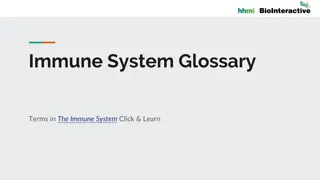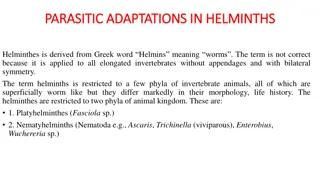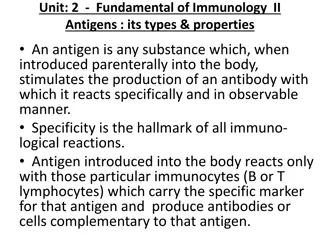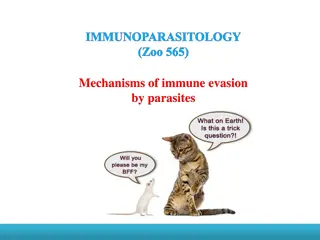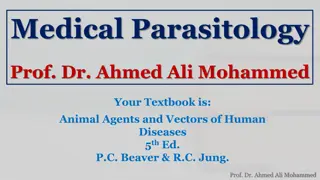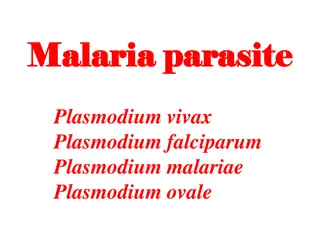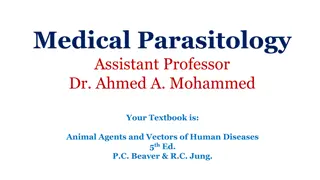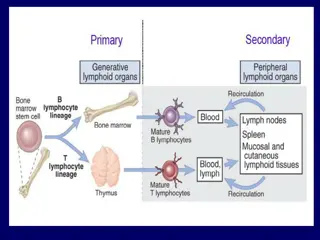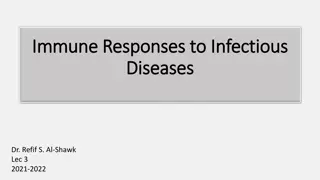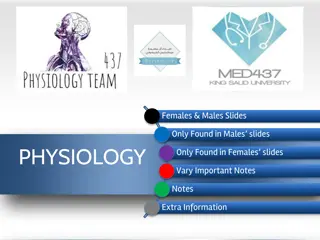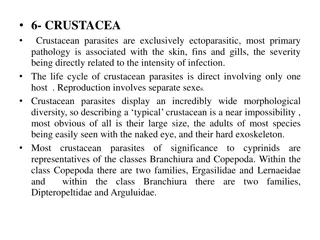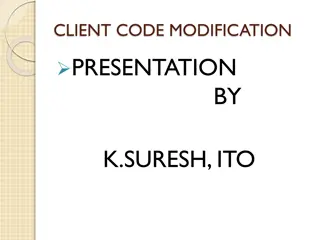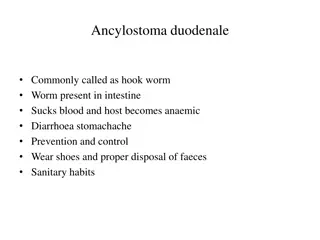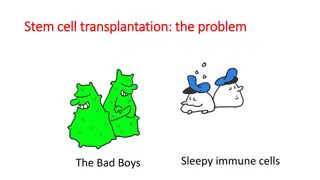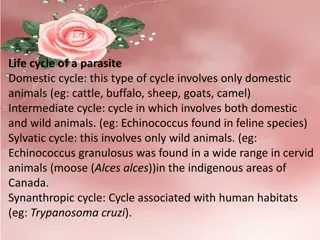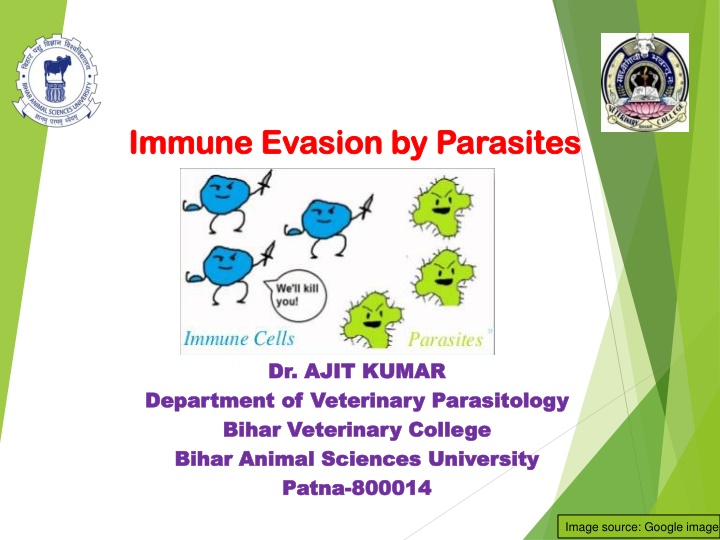
Immune Evasion Mechanisms by Parasites in Veterinary Parasitology
Explore the fascinating world of immune evasion by parasites, including mechanisms such as antigenic variation, disguise, shedding, and more. Learn how parasites adapt to survive and proliferate within their hosts, with a focus on Trypanosoma spp. examples.
Download Presentation

Please find below an Image/Link to download the presentation.
The content on the website is provided AS IS for your information and personal use only. It may not be sold, licensed, or shared on other websites without obtaining consent from the author. If you encounter any issues during the download, it is possible that the publisher has removed the file from their server.
You are allowed to download the files provided on this website for personal or commercial use, subject to the condition that they are used lawfully. All files are the property of their respective owners.
The content on the website is provided AS IS for your information and personal use only. It may not be sold, licensed, or shared on other websites without obtaining consent from the author.
E N D
Presentation Transcript
Bihar Animal Sciences University | Immune Evasion by Parasites Immune Evasion by Parasites Dr. AJIT KUMAR Dr. AJIT KUMAR Department of Veterinary Parasitology Department of Veterinary Parasitology Bihar Veterinary College Bihar Veterinary College Bihar Animal Sciences University Bihar Animal Sciences University Patna Patna- -800014 800014 Image source: Google image
Immune Evasion by Parasites Parasites Parasites have have various various mechanism mechanism of of immune immune evasion, evasion, so so that that they they can can survive survive and and proliferate proliferate in in the the host host . . The The following following evasion evasion mechanism mechanism uses uses by by the the parasites parasites: :- - Antigenic Antigenic variation variation 1. 1. Antigenic Antigenic disguise disguise 2. 2. Antigenic Antigenic shedding shedding 3. 3. Immune Immune suppression suppression 4. 4. Immune Immune complex complex formation formation 5. 5. Inert Inert cuticular cuticular surface surface 6. 6. Location Location in in protective protective site site 7. 7. Modified Modified leucocytic leucocytic function function 8. 8.
Immune Evasion by Parasites Antigenic Antigenic variation variation: : 1. 1. It is a phenomenon in which parasites shed the outer Variant Surface Glycoprotein (VSG) coat and replace it with another one on every 7-10 days. Therefore, immune response developed against preceding VSG, can not work with subsequent antigenically different VSG and the parasites thus evade the host immune response. Example- Trypanosoma spp.
Immune Evasion by Parasites Antigenic Antigenic variation variation: :
Immune Evasion by Parasites o Antigenic Variation : o Trypanosomes have antigenic variation character due to variant surface glycoproteins (VSG). Image source: Google image
Immune Evasion by Parasites o Antigenic Variation: o The surface coat of trypanosomes is a 12- 15 mm thick layer made up of about 107 identical molecules of approximately 60 kDa which are closely packed to cover the entire surface. These molecules are variant surface glycoproteins (VSGs). Image source: Google image
Immune Evasion by Parasites o Antigenic Variation: Changing trypanosomes in vertebrate s hosts, the development of an against trypanosomes is difficult. antigenic characters of effective vaccine Image source: Google image
Immune Evasion by Parasites 2 2. . Antigenic Antigenic disguise disguise : :- - It It is their their molecules molecules like is mechanism mechanism where antigens antigens like RBCs, where the by by RBCs, immunoglobulin immunoglobulin etc the parasites parasites mask incorporating incorporating mask host host etc. . e e. .g g. . Schistosoma Schistosoma spp spp. . Schistosoma
Immune Evasion by Parasites 3 3. . Antigenic Antigenic mimicry mimicry : :- - It It is their their molecules molecules like is mechanism mechanism where antigens antigens like RBCs, where the by by RBCs, immunoglobulin immunoglobulin etc the parasites parasites mask incorporating incorporating mask host host etc. . e e. .g g. . Schistosoma Schistosoma spp spp. . Schistosoma
Immune Evasion by Parasites shedding: :- - 4 4. . Antigenic Antigenic shedding Nematodes Nematodes shed shed their their whole antigenic antigenic molecules molecules during and and some whole cuticular cuticular sheath during molting some other other parasites parasites sheath and and also molting. . also e e. .g g. . falcifarum falcifarum , , Entamoeba Schistosoma Schistosoma mansoni Entamoeba, , Ancylostoma mansoni, , Plasmodium Plasmodium Ancylostoma, , etc etc. .
Immune Evasion by Parasites shedding: :- - Antigenic Antigenic shedding molecules molecules during during molting molting. . Parasites Parasites shed abundance abundance can at at a a distance distance away help help the the parasites parasites to protective protective response response. . shed their can neutralize neutralize antibody away from from the to evaded their antigens antigens antibody response the parasites parasites. . This evaded the the host s in in response This host s Schistosoma
Immune Evasion by Parasites 5 5. . Immune Immune suppression suppression: :- - Many Many specific specific lymphotoxicity lymphotoxicity, , produces leads leads to to inhibition inhibition of parasites parasites immune immune stimulate stimulate suppressor suppressor produces blocking of immune immune system production production cells, cells, antibodies and system of of hosts hosts. . the the of of induce induce and blocking antibodies e e. .g g. . Schistosoma Schistosoma, , Trypanosoma Trypanosoma , , Plasmodium Plasmodium etc etc. .
Immune Evasion by Parasites Complex formation formation: :- - 6 6. . Immune Immune Complex Parasite Parasite Plasmodium Plasmodium spp system system by by immune like like spp. . evade immune complex Toxoplasma Toxoplasma evade the complex formation gondii gondii hosts immune immune formation. . and and the hosts e e. .g g. . Toxoplasma Toxoplasma gondii gondii, , Plasmodium Plasmodium etc etc. .
Immune Evasion by Parasites surface: :- - 7 7. . Inert Inert cuticular cuticular surface Helminthes Helminthes immunologically immunologically inert helps helps in in evasion evasion of especially especially inert cuticular cuticular surface of host s host s immune immune response nematodes nematodes surface. . This response. . have have This
Immune Evasion by Parasites 8 8. . Sequestration Sequestration of of parasites parasites ( ( Location Location of of parasites parasites in in a a protective protective site) site)
Immune Evasion by Parasites 10 10. . Survive Survive in in macrophage macrophage by fusion: :- - by Preventing Preventing phago phago- -lysosome lysosome fusion e e. .g g. . Leishmania Leishmania, , Trypanosoma etc etc. . Trypanosoma, , Toxoplasma Toxoplasma Amastigote stage of Leishmania spp. Macrophage
Immune Evasion by Parasites function: :- - 11 11. . Modified Modified leucocytic leucocytic function Parasites Parasites like Fasciola Fasciola hepatica factors factors which which can functions functions and system system. . like Schistosoma Schistosoma mansoni hepatica release release some can alter alter the and evade evade the mansoni and some inhibitory inhibitory the leucocytic leucocytic the host s host s immune and immune
Immune Evasion by Parasites 12 12. . responsiveness: :- - Neonatal Neonatal immunological immunological responsiveness Young Young animals animals are immune immune infections infections. . are unable unable to response response to develop develop a a proper to to some some proper parasitic parasitic
Effects of Immune Response on Parasites oUsually Usually expel parasites parasites after expel the after development development of the adults adults and and larvae larvae of of immunity immunity. . of e e. .g g. . Self Self- -cure cure Phenomenon Phenomenon Concomitant Concomitant Immunity Immunity oPreventimg Preventimg the of of larvae larvae or development development of the migration migration and or sometimes, sometimes, by of larvae larvae in and establishment establishment by arresting arresting the in re re- -infection infection. . the oStunting Stunting fecundity fecundity of of of parasites. . growth growth and and reduction reduction of of of parasites
Effects of Immune Response on Parasites
Effects of Immune Response on Parasites
Effects of Immune Response on Parasites Concomitant Concomitant immunity immunity: : An An immunity immunity which which acts acts against against invading invading larval larval stages stages, , but but not not against against an an existing existing infection infection. . Thus, Thus, a a host host may may be be infected infected with with adult adult parasites parasites or or established established larval larval of of cestodes cestodes but but has has a a measure measure of of immunity immunity to to further further infection infection. e e. .g g. . Schistosoma Schistosoma infection infection. .


